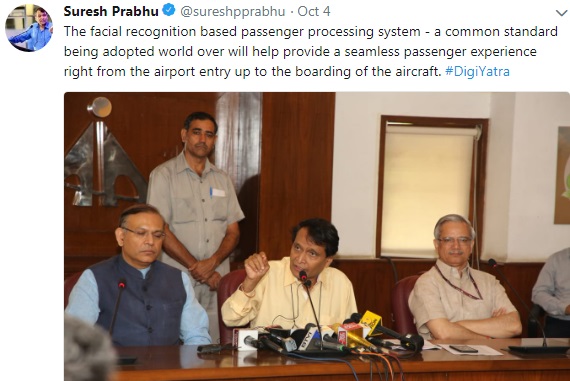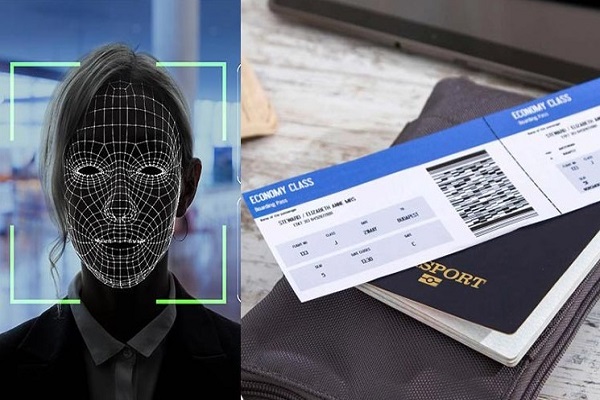The Union Minister of Commerce and Industry & Civil Aviation, Shri Suresh Prabhu released the policy on biometric based digital processing of passengers at airports called “Digi Yatra†at a press-conference. He said that the Ministry has taken the initiative to develop standards for digital processing of passengers at airport to ensure uniform implementation and passenger experience across Indian airports through a connected ecosystem. He said, a technical working committee having members from airport operators, airlines and industry has been formed for development of standards.

(Also read: UPSC allows facility of withdrawal of applications by candidates)
DigiYatra Central Platform will be operational by end of February, 2019. Bangalore & Hyderabad International Airports will be ready with pilot implementation by end of February, 2019. Airport Authority of India (AAI) intends to roll out the programme initially at Kolkata, Varanasi, Pune & Vijayawada by April, 2019.
(Also read: Now Aadhar is NOT mandatory for Bank Account, SIM, Exams, says SC)
Shri Suresh Prabhu said, DigiYatra will provide a pan-India powerful platform for future, adding that Airports will have the possibility of providing innovative services and consent based targeted services in future. “Any service provider involved in facilitating travel of passenger from door to door will be able to use this platform in future through innovative solutionsâ€, he said.
(Also read: Petroleum Minister launches SATAT initiative to promote Compressed Bio-Gas as an alternative, green transport fuel)
Elaborating on the contours of Digi Yatra, Minister of State of Civil Aviation, Shri Jayant Sinha said, it is a Facial Recognition based passenger processing which is a common standard being adopted the world over. To provide a seamless experience right from the entry to the airport upto boarding the aircraft, DigiYatra will have a centralised registration system for passengers.

“Under the Digi Yatra, passenger can get a Digi Yatra ID by sharing minimum details like Name, e-mail ID, Mobile number and details of one approved Identity proof where Aadhar ID is not mandatory. This DigiYatra ID will be shared by passengers while booking ticket. Airlines will share the passenger data and DigiYatraID with the departure airportâ€.
Shri Sinha pointed out that a passenger who has created the Digi Yatra ID has to undergo a onetime verification at the departure airport during his/her first travel. “In case a passenger opted for Aadhar based verification, the identity will be verified online. On successful verification, facial biometric will be captured and stored in the Digi Yatra ID profile of the passenger. In case the passenger has chosen any other identity for creating Digi Yatra ID, verification will be done manually by Security personal and facial biometric will be captured and stored in the Digi Yatra ID profile. By this process the registration is completeâ€.
A successfully registered passenger can go directly to the entry point E-Gate of the airport and scan the barcode/ QR code of the ticket/ Boarding pass. “A camera will capture the face for comparing with DigiYatraID Photo. On successful verification of the travel details and facial matching, the E-Gate will open. The system will also generate a token in the system combining the face of passenger with PNR of the ticket, so that at subsequent check points the ticket details will be available on face recognition.â€
(Also read: Government constitutes Competition Law Review Committee to review the Competition Act)
“At check-in counter or at the Self Bag Drop counter, the passenger will be identified by face and there is no need to show any document or ID for this purpose. The passenger will gain entry to the security check area through an E-Gate by facial recognition. Similarly at the boarding gate also the passenger will be identified by face for entering through an E-Gate for boarding the aircraft.â€
(Also read: High Level Committee Constituted on Corporate Social Responsibility (CSR))
“Airlines will have the information of its passenger and their status within the terminal. No more missing passenger causing departure delays. Security will benefit from the ability of the technology to verify the passenger at every checkpoint in a non intrusive way except that physical frisking of the passenger as per security procedures will continue. Intentional Boarding pass exchange by passenger or wrong boarding by mistake will not happen.â€
Shri Jayant Sinha said, Digi Yatra will bring benefits to passengers and all stakeholders involved in the process, as Airport operator will have travel information in advance for better resource planning and the real-time data of passengers within the terminal will enable the operator to take proactive action to avoid congestion.
(Also read: IT Minister inaugurates Centre of Excellence for Data Analytics and DigiVaarta)
“The passengers are expecting better facilitation at the airport and Security remains a key concern in air travel. Leveraging technology is the only solution to meet such challenging requirementsâ€, Shri Choubey said. Pointing out that multiple stakeholders are involved in a seamless travel process for a passenger, he emphasised that it was important that the stakeholders work in a connected environment for reaping the benefits of technology. He said, in order to achieve this objective, the Ministry of Civil Aviation evolved the concept of “DigiYatra†which envisages a connected ecosystem enhancing the seamless travel experience for the passengers and simultaneously improving the security.
For more updates:
1. Like our Facebook Page
2. Join our Telegram Group
3. Join our Facebook Group
4. Subscribe to our Youtube Channel
5. Follow us on Twitter
6. Follow us on Instagram
Disclaimer: The above post includes some content used from PIB India website and executed on this website for fair use only. As this website is of educational nature, hence the content is used for education and awareness to the public.

